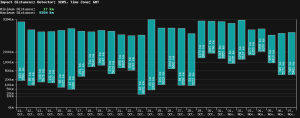
Loyal readers of this blog will recall (blog article) that I have constructed and have placed into service a station that detects a lightning strike and reports it to a crowd-sourced system that uses the report to determine where the lightning strike happened. Hundreds or thousands of times per day, my station detects a lightning strike and reports it to the crowd-sourced system.
The alert reader will surely wonder “how far away are these lightning strikes?” Today’s blog article answers this question, and it draws upon the screen shot that you see above.
The graph that you see above is a screen shot from a real-time source that you can see here. By clicking on that link you see a real-time graph entitled “impact distances” for my station which is station number 3205. It has 28 vertical bars, each reporting the impact distances for lightning strikes that my station detected on each of the 28 most recent days. (The image at the top of the article is a screen shot from that real-time graph.)
As you can see, as of today the most nearby lightning strike that my station detected was 17 kilometers away (about 10 miles) and the furthest-away lightning strike that my station detected was 9394 kilometers away (about 5800 miles). Of course you may be reading this article (and clicking on that link) on some later date and the numbers might be different.
The distance (as measured on a path on the surface of the Earth) to the farthest-away point on the Earth is about 20000 kilometers. 9394 is about 47% of 2000. This means that some of the lightning strikes detected by my station are nearly half-way around the world.
Most of the far-away strikes detected by my station are in or near Mexico or the Caribbean.
What this reminds us is that no single station in this crowd-sourced system actually figures out where any particular lightning strike happened. Any single station merely notes the exact time that the strike was detected by that station. And I do mean the exact time, using an extremely precise time source that draws upon GNSS signals. The crowd-sourced system draws upon reports from dozens of stations (including my station) to pin down the exact location of any particular detected lightning strike, using some clever math to triangulate the location of the lightning strike.
The electromagnetic signal emitted by a lightning strike travels at the speed of light, which is about 300,000 kilometers per second (about 186,000 miles per second). This means that a strike in the Caribbean generates a magnetic pulse that arrives at my station around 1/30th of a second after the strike happened. The crowd-sourced system uses this delay of perhaps 1/30th of a second and compares it to delays reported by other stations, to work out (by triangulation) where the strike happened. As you can appreciate from the smallness of this interval, this process of locating a lightning strike works only because each station knows exactly what time it is at that station.
My station makes use of precise time signals from GPS (US), Galileo (European), and Glonass (Russian) satellites to work out the time of day to a precision of a few nanoseconds.

What is the sensor for the lightning/EMF strikes?
See https://ha-user.com/my-blitzortung-lightning-sensing-station/